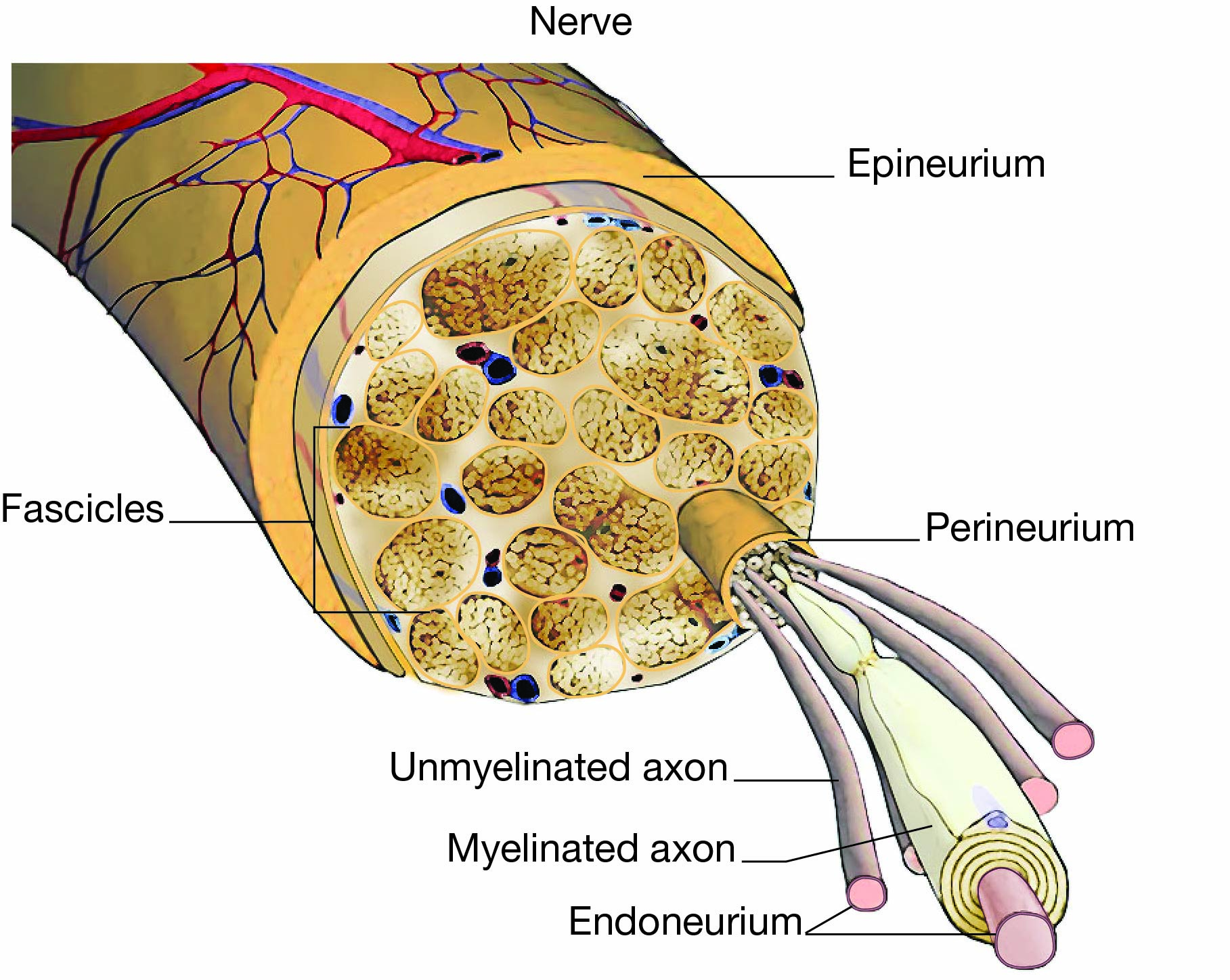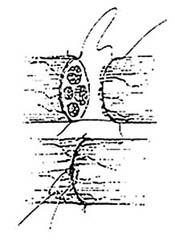Diseases & Conditions
Nerve Injuries in the Hand and Fingers
Nerves connect our brain and spinal cord to the rest of our body.
- They carry signals from the body to the brain telling us about pain, pressure, temperature, etc. For instance, when your finger gets hit by a ball, the nerves signal the brain that your finger is hurt, and you feel pain.
- They carry signals from our brain to our body, allowing us to move our limbs and complete tasks.
Nerves are fragile and can be damaged by pressure, stretching, or cutting. Injury to a nerve can stop signals to and from the brain. This can cause muscles to stop working properly and result in loss of feeling.
In many cases, nerve injuries can be treated to improve outcomes. However, nerves are very complex structures and do not recover as well as ligaments, tendons, and bones. Despite optimal treatment, many nerve injuries result in some level of permanent dysfunction (loss of normal function) in the hand or fingers.
Anatomy
Nerves are part of the "electrical wiring" system of our bodies that carries messages between the brain and the rest of the body.
- Motor nerves carry messages between the brain and muscles to make the body move.
- Sensory nerves carry messages between the brain and different parts of the body to signal pain, pressure, temperature, etc.
Nerves are very complex:
- Nerves are covered by a ring of protective tissue (epineurium), just like insulation surrounding an electrical cable.
- Within the epineurium, the nerve fibers are grouped into several cables called fascicles. These long groups of nerve fibers are surrounded by another protective layer called perineurium.
- The individual nerve fibers are made up of a very specialized part of a cell called an axon — which allows cells to communicate with one another via electrical signaling — and covered by a final protective layer called endoneurium. Injury to this complex inner structure can result in disruption of the signal and dysfunction of the nerve.
Cause
Pressure or stretching injuries can cause fibers within the nerve to break. The outer epineurium is stronger than the other layers and often remains intact (unbroken). However, the complex inner layers of the nerve are disrupted. This may interfere with the nerve's ability to send or receive signals despite there being relatively little damage to the outer layer.
Inside the intact outer layer, the end of the nerve farthest from the brain dies and degenerates (deteriorates). However, the end that is closest to the brain does not die. If the epineurium is intact (unbroken), after some time, the nerve may begin to heal as the living nerve fibers find their way back to the muscle and skin.
In very severe cases, the pressure or stretch is so great that even the epineurium is damaged. These cases often require surgery to achieve any meaningful recovery, since the roadmap provided by the outer layer of the nerve is disrupted and the living nerve fibers can't find their way back to the muscle and skin.
Similarly, when a nerve is completely cut, both the inner nerve layers and the outer epineurium are damaged. In those cases, surgery is often needed to put the epineurium back together so the nerve fibers can find their way back to where they need to go.
If both the nerve and insulation have been severed and the nerve is not fixed, the growing nerve fibers may form a painful nerve scar, or neuroma. This is caused by disorganized growth of nerve fibers, which results in a large and painful ball of nerves.
Symptoms
Symptoms of nerve injuries vary.
- Injured sensory nerves typically cause pain and/or numbness. The area controlled by the nerve no longer tells the brain about pain, temperature, and pressure. The raw nerve end can be very painful.
- Injured motor nerves result in loss of function of the controlled muscle. For example, injury to the radial nerve will result in an inability to straighten your fingers/thumb and extend your wrist. Many nerves are “mixed,” meaning injury to these nerves results in both sensory (feeling) and motor (function) issues.
In severe cases, injury to nerves can result in a severely painful condition called complex regional pain syndrome (CRPS).
Doctor Examination
Your doctor will typically start by asking about the injury and your health history. They will want to know:
- How the injury occurred and how long ago it happened
- What symptoms you are having — including whether you are having problems with sensation (feeling) or function
- If you have had any previous treatments for this injury or for past issues in the affected hand
- If you have any other medical issues, such as a chronic health condition like diabetes or heart disease
- Which medications and supplements you are taking
Physical Examination
The doctor will likely examine you and focus on the area of injury. They will:
- Test the feeling in the injured limb as well as your ability to move various muscles in that limb
- Check for other injuries associated with the nerve injury (e.g., vessel, tendon, bone, etc.) that may also need to be addressed
Imaging Tests
Depending on the injury, a variety of imaging tests may be helpful.
- Your doctor may order X-rays to look for associated broken bones or dislocated joints
- MRI or Ultrasound may help show the nerve injury and the “zone of injury” around the nerve, which can help with surgical planning.
Electromyography and nerve conduction studies (electrodiagnostic testing) can help in the diagnosis and treatment of nerve injuries. Depending on the type of nerve injury you have, your doctor may request these studies.
Nonsurgical Treatment
Many minor “nerve palsies” can be treated non-operatively. These are pressure or stretching injuries to the nerve that do not damage the outer protective layer (epineurium). If the outer layer is intact (unbroken), nerves can often heal over time and allow for return of function. The location and function of the nerve will determine the healing potential and time to healing.
- In these situations, sometimes EMG/NCS can help with prognosis (the likely course of the injury) and prediction of recovery.
- You may need a series of visits with your doctor, including examinations of the affected hand(s) to ensure proper recovery.
- Therapy is often helpful to keep joints supple (flexible) until muscle function returns and to help with strengthening when the function comes back.
Temporary splints may also be useful to keep joints aligned (lined up) properly while waiting for nerve recovery.
Surgical Treatment
Surgery to help with nerve recovery may be needed for nerve injuries where:
- The outer layer of the nerve (epineurium) is severely damaged and/or completely disrupted (broken) and/or
- The inner layers of the nerve are damaged beyond the ability to recover on their own
In fresh nerve lacerations (cuts, or tears), the outer layer (epineurium) around both ends of the injured nerve is sewn together. The goal in fixing the nerve is to save the insulating cover so that new fibers can grow back to where they need to go using the epineurium as a roadmap.
It is important that these repairs be precise and without tension (meaning, there should be plenty of slack in the repaired nerves). For small nerves, the surgeon may need to use a microscope to clearly see and repair the epineurium.
If a wound is dirty or crushed, surgery may be delayed until the skin has healed.
If the nerve ends have sprung apart or there is a missing part of the nerve resulting in a space between the ends of the nerve, it may be necessary to take a piece of nerve (nerve graft) from another part of your body to fix the injured nerve. This may cause permanent loss of feeling in the area where the donor nerve graft was taken.
Another approach is to use a nerve allograft, which is a donor nerve from another person that has been processed in a laboratory and frozen for later use. While it is expensive, with this approach there is no risk of an injury to the donor nerve.
If the gap between the nerve ends is small (less than 1 cm), a nerve conduit can help bridge the gap. Nerve conduits are synthetic (artificial) insulation for the nerve made of collagen. They help create a new epineurium-like layer and can act as a roadmap for the repaired nerve even if there is a small gap. The latest conduits are even being made with specially-engineered filling to act more like a nerve allograft.
Once the insulating cover of the nerve is repaired, the nerve generally begins to heal 3 or 4 weeks after the injury.
Nerves usually grow 1 inch every month, depending on the patient's age and other factors. With an injury to a nerve in the arm above the fingertips, it may take up to 1 year before feeling returns to the fingertips. The feeling of pins and needles in the fingertips is common during the recovery process. While this can be uncomfortable, it usually passes and is a sign of recovery.
Recovery and Outcomes
- Therapy is often necessary to keep affected joints flexible until the nerves recover. If the joints become stiff, they will not work, even after the muscles begin to work again.
- If a sensory nerve has been injured, you must take care not to burn or cut fingers while there is no feeling in the affected area.
- With a nerve injury, the brain may need to be "re-educated." After the nerve has recovered, motor and/or sensory re-education may be needed to improve feeling in the hand or finger. Your physician will recommend appropriate therapy based on the nature and location of the injury.
Factors that may affect results after nerve repair include:
- Your age
- The type of wound/injury and which nerve(s) are affected
- The location of the injury
Although nerve injuries may create lasting problems, proper treatment helps patients return to more normal function.
Other Treatments
Some nerve injuries cannot be repaired and require other methods of treatment.
Nerve Transfer. Sometimes, nerve injuries can be treated with a nerve transfer. This is a procedure where a redundant (non-essential, or spare), functioning nerve is attached to the injured nerve to provide it with function. If successful, the donor nerve can breathe new life into the injured nerve, allowing for improved function. Typically, a lot of therapy is required after a successful nerve transfer to help retrain the brain to use the nerve correctly.
Tendon Transfer. If a nerve injury cannot be fixed and nerve transfer is not possible, tendon transfer can be an option.
In this procedure, a redundant (non-essential, or spare), functioning tendon is transferred to a tendon whose muscle is no longer working due to the nerve injury. These procedures are carefully thought-out so you don’t notice the loss of the donor tendon, and the strength and function of the donor tendon is enough to power the recipient tendon.
As in nerve transfers, tendon transfers often require a lot of therapy to ensure proper function once the transfer has healed.
Contributed and/or Updated by
Peer-Reviewed by
AAOS does not endorse any treatments, procedures, products, or physicians referenced herein. This information is provided as an educational service and is not intended to serve as medical advice. Anyone seeking specific orthopaedic advice or assistance should consult his or her orthopaedic surgeon, or locate one in your area through the AAOS Find an Orthopaedist program on this website.








